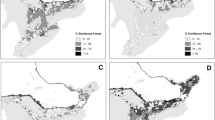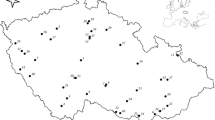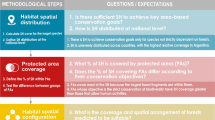Abstract
Models predicting the occurrence of area-sensitive bird species in forests were developed from bird survey data from 499 forests in Prince George's County, Maryland. The predicted probabilities of occurrence for species were integrated with forest cover data for the County in a Geographic Information System (GIS). This information was used in combination with local zoning and forest conservation requirements to develop a preliminary forest conservation plan for the watershed of the Western Branch of the Patuxent River. We identify forests patches most likely to support breeding populations of area-sensitive birds, and use the GIS to devise ways to consolidate and link them. Forests that do not contribute significantly to the integrity of these priority forests are designated as sites in which development could occur. The resulting conservation plan will maintain and enhance breeding habitat for area-sensitive forest birds, while still allowing for additional development as human populations increase.
Similar content being viewed by others
References
Ambuel, B. and Temple, S. A. (1983) Area-dependent changes in the bird communities and vegetation of southern Wisconsin forests. Ecology 64, 1057-68.
Blake, J. G. and Karr, J. R. (1987) Breeding birds of isolated woodlots: area and habitat relationships. Ecology 68, 1724-34.
Cox, D. R. and Snell, E. J. (1989) Analysis of Binary Data, 2nd ed. Chapman and Hall, London.
Dawson, D. K., Darr, L. J. and Robbins, C. S. (1993) Predicting the distribution of breeding forest birds in a fragmented landscape. Trans. North Am. Wildl. Nat. Resour. Conf. 58, 35-43.
Freemark, K. and Merriam, H. G. (1986) Importance of area and habitat heterogeneity to bird assemblages in temperate forest fragments. Biol. Conserv. 36, 115-41.
Galli, A. E., Leck, C. F. and Forman, R. T. T. (1976) Avian distribution patterns in forests of different sizes in central New Jersey. Auk 93, 356-64.
Hayden, T. J., Faaborg, J. and Clawson, R. L. (1985) Estimates of minimum area requirements for Missouri forest birds. Trans. Missouri Acad. Sci. 19, 11-22.
Lynch, J. F. and Whigham, D. F. (1984) Effects of forest fragmentation on breeding bird communities in Maryland, USA. Biol. Conserv. 28, 287-324.
Paton, P. W. C. (1994) The effect of edge on avian nest success: how strong is the evidence? Conserv. Biol. 8, 17-26.
Petit, L. J., Petit, D. R. and Martin, T. E. (1995) Landscape-level management of migratory birds: looking past the trees to see the forest. Wildl. Soc. Bull. 23, 420-29.
Prince George's County. (1992) Prince George's County Woodland Conservation and Tree Preservation Policy Document. Upper Marlboro, MD.
Pulliam, H. R. (1988) Sources, sinks, and population regulation. Am. Nat. 132, 652-61.
Robbins, C. S., Dawson, D. K. and Dowell, B. A. (1989) Habitat area requirements of breeding forest birds of the Middle Atlantic states. Wildl. Monogr. 103, 1-34.
SAS Institute Inc. (1989) SAS/STAT user's guide. Version 6, 4th ed., vol.2. SAS Institute, Inc., Cary, NC.
Strittholt, J. R. and Boerner, R. E. J. (1995) Applying biodiversity gap analysis in a regional nature reserve design for the Edge of Appalachia, Ohio (U.S.A.). Conserv. Biol. 9, 1492-1505.
Whitcomb, R. F., Robbins, C. S., Lynch, J. F., Whitcomb, B. L., Klimkiewicz, M. K. and Bystrak, D. (1981) Effects of forest fragmentation on avifauna of the eastern deciduous forest. In Forest Island Dynamics in Man-Dominated Landscapes(R. L. Burgess and D. M. Sharpe, eds) pp. 125-206. Springer-Verlag, New York.
Author information
Authors and Affiliations
Rights and permissions
About this article
Cite this article
Darr, L.J., Dawson, D.K. & Robbins, C.S. Land-use planning to conserve habitat for area-sensitive forest birds. Urban Ecosystems 2, 75–84 (1998). https://doi.org/10.1023/A:1009569329324
Issue Date:
DOI: https://doi.org/10.1023/A:1009569329324




